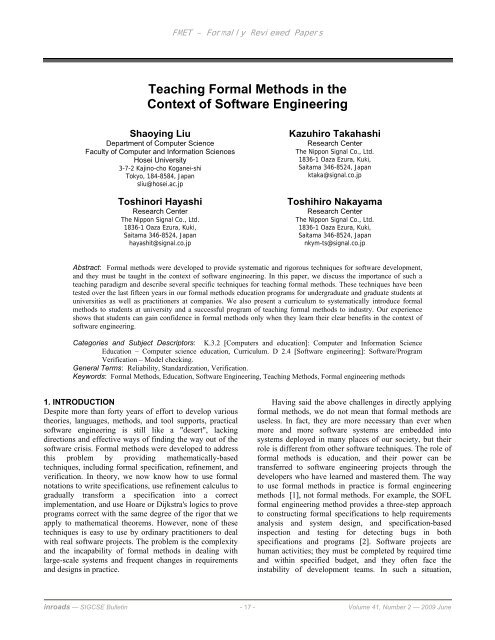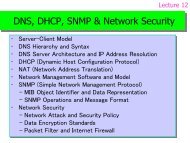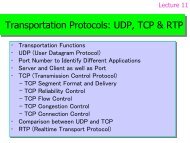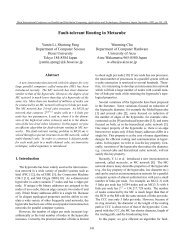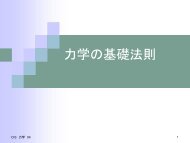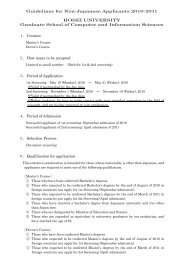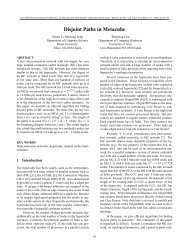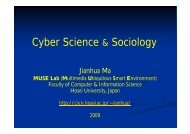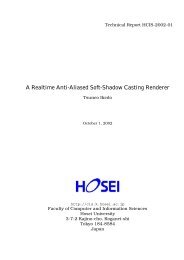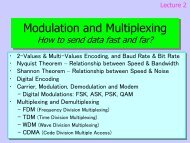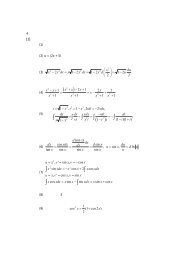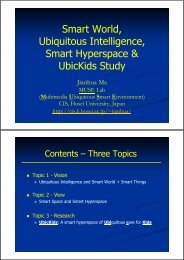Teaching formal methods in the context of software engineering
Teaching formal methods in the context of software engineering
Teaching formal methods in the context of software engineering
You also want an ePaper? Increase the reach of your titles
YUMPU automatically turns print PDFs into web optimized ePapers that Google loves.
FMET – Formally Reviewed Papers<br />
<strong>Teach<strong>in</strong>g</strong> Formal Methods <strong>in</strong> <strong>the</strong><br />
Context <strong>of</strong> S<strong>of</strong>tware Eng<strong>in</strong>eer<strong>in</strong>g<br />
Shaoy<strong>in</strong>g Liu<br />
Department <strong>of</strong> Computer Science<br />
Faculty <strong>of</strong> Computer and Information Sciences<br />
Hosei University<br />
3-7-2 Kaj<strong>in</strong>o-cho Koganei-shi<br />
Tokyo, 184-8584, Japan<br />
sliu@hosei.ac.jp<br />
Tosh<strong>in</strong>ori Hayashi<br />
Research Center<br />
The Nippon Signal Co., Ltd.<br />
1836-1 Oaza Ezura, Kuki,<br />
Saitama 346-8524, Japan<br />
hayashit@signal.co.jp<br />
Kazuhiro Takahashi<br />
Research Center<br />
The Nippon Signal Co., Ltd.<br />
1836-1 Oaza Ezura, Kuki,<br />
Saitama 346-8524, Japan<br />
ktaka@signal.co.jp<br />
Toshihiro Nakayama<br />
Research Center<br />
The Nippon Signal Co., Ltd.<br />
1836-1 Oaza Ezura, Kuki,<br />
Saitama 346-8524, Japan<br />
nkym-ts@signal.co.jp<br />
Abstract: Formal <strong>methods</strong> were developed to provide systematic and rigorous techniques for s<strong>of</strong>tware development,<br />
and <strong>the</strong>y must be taught <strong>in</strong> <strong>the</strong> <strong>context</strong> <strong>of</strong> s<strong>of</strong>tware eng<strong>in</strong>eer<strong>in</strong>g. In this paper, we discuss <strong>the</strong> importance <strong>of</strong> such a<br />
teach<strong>in</strong>g paradigm and describe several specific techniques for teach<strong>in</strong>g <strong>formal</strong> <strong>methods</strong>. These techniques have been<br />
tested over <strong>the</strong> last fifteen years <strong>in</strong> our <strong>formal</strong> <strong>methods</strong> education programs for undergraduate and graduate students at<br />
universities as well as practitioners at companies. We also present a curriculum to systematically <strong>in</strong>troduce <strong>formal</strong><br />
<strong>methods</strong> to students at university and a successful program <strong>of</strong> teach<strong>in</strong>g <strong>formal</strong> <strong>methods</strong> to <strong>in</strong>dustry. Our experience<br />
shows that students can ga<strong>in</strong> confidence <strong>in</strong> <strong>formal</strong> <strong>methods</strong> only when <strong>the</strong>y learn <strong>the</strong>ir clear benefits <strong>in</strong> <strong>the</strong> <strong>context</strong> <strong>of</strong><br />
s<strong>of</strong>tware eng<strong>in</strong>eer<strong>in</strong>g.<br />
Categories and Subject Descriptors: K.3.2 [Computers and education]: Computer and Information Science<br />
Education – Computer science education, Curriculum. D 2.4 [S<strong>of</strong>tware eng<strong>in</strong>eer<strong>in</strong>g]: S<strong>of</strong>tware/Program<br />
Verification – Model check<strong>in</strong>g.<br />
General Terms: Reliability, Standardization, Verification.<br />
Keywords: Formal Methods, Education, S<strong>of</strong>tware Eng<strong>in</strong>eer<strong>in</strong>g, <strong>Teach<strong>in</strong>g</strong> Methods, Formal eng<strong>in</strong>eer<strong>in</strong>g <strong>methods</strong><br />
1. INTRODUCTION<br />
Despite more than forty years <strong>of</strong> effort to develop various<br />
<strong>the</strong>ories, languages, <strong>methods</strong>, and tool supports, practical<br />
s<strong>of</strong>tware eng<strong>in</strong>eer<strong>in</strong>g is still like a "desert", lack<strong>in</strong>g<br />
directions and effective ways <strong>of</strong> f<strong>in</strong>d<strong>in</strong>g <strong>the</strong> way out <strong>of</strong> <strong>the</strong><br />
s<strong>of</strong>tware crisis. Formal <strong>methods</strong> were developed to address<br />
this problem by provid<strong>in</strong>g ma<strong>the</strong>matically-based<br />
techniques, <strong>in</strong>clud<strong>in</strong>g <strong>formal</strong> specification, ref<strong>in</strong>ement, and<br />
verification. In <strong>the</strong>ory, we now know how to use <strong>formal</strong><br />
notations to write specifications, use ref<strong>in</strong>ement calculus to<br />
gradually transform a specification <strong>in</strong>to a correct<br />
implementation, and use Hoare or Dijkstra's logics to prove<br />
programs correct with <strong>the</strong> same degree <strong>of</strong> <strong>the</strong> rigor that we<br />
apply to ma<strong>the</strong>matical <strong>the</strong>orems. However, none <strong>of</strong> <strong>the</strong>se<br />
techniques is easy to use by ord<strong>in</strong>ary practitioners to deal<br />
with real s<strong>of</strong>tware projects. The problem is <strong>the</strong> complexity<br />
and <strong>the</strong> <strong>in</strong>capability <strong>of</strong> <strong>formal</strong> <strong>methods</strong> <strong>in</strong> deal<strong>in</strong>g with<br />
large-scale systems and frequent changes <strong>in</strong> requirements<br />
and designs <strong>in</strong> practice.<br />
Hav<strong>in</strong>g said <strong>the</strong> above challenges <strong>in</strong> directly apply<strong>in</strong>g<br />
<strong>formal</strong> <strong>methods</strong>, we do not mean that <strong>formal</strong> <strong>methods</strong> are<br />
useless. In fact, <strong>the</strong>y are more necessary than ever when<br />
more and more s<strong>of</strong>tware systems are embedded <strong>in</strong>to<br />
systems deployed <strong>in</strong> many places <strong>of</strong> our society, but <strong>the</strong>ir<br />
role is different from o<strong>the</strong>r s<strong>of</strong>tware techniques. The role <strong>of</strong><br />
<strong>formal</strong> <strong>methods</strong> is education, and <strong>the</strong>ir power can be<br />
transferred to s<strong>of</strong>tware eng<strong>in</strong>eer<strong>in</strong>g projects through <strong>the</strong><br />
developers who have learned and mastered <strong>the</strong>m. The way<br />
to use <strong>formal</strong> <strong>methods</strong> <strong>in</strong> practice is <strong>formal</strong> eng<strong>in</strong>eer<strong>in</strong>g<br />
<strong>methods</strong> [1], not <strong>formal</strong> <strong>methods</strong>. For example, <strong>the</strong> SOFL<br />
<strong>formal</strong> eng<strong>in</strong>eer<strong>in</strong>g method provides a three-step approach<br />
to construct<strong>in</strong>g <strong>formal</strong> specifications to help requirements<br />
analysis and system design, and specification-based<br />
<strong>in</strong>spection and test<strong>in</strong>g for detect<strong>in</strong>g bugs <strong>in</strong> both<br />
specifications and programs [2]. S<strong>of</strong>tware projects are<br />
human activities; <strong>the</strong>y must be completed by required time<br />
and with<strong>in</strong> specified budget, and <strong>the</strong>y <strong>of</strong>ten face <strong>the</strong><br />
<strong>in</strong>stability <strong>of</strong> development teams. In such a situation,<br />
<strong>in</strong>roads — SIGCSE Bullet<strong>in</strong> - 17 - Volume 41, Number 2 — 2009 June
FMET – Formally Reviewed Papers<br />
completely apply<strong>in</strong>g <strong>formal</strong> <strong>methods</strong> is rarely practical, but<br />
<strong>the</strong> improvement <strong>of</strong> s<strong>of</strong>tware quality can be realized by<br />
equipp<strong>in</strong>g <strong>the</strong> developers with a discipl<strong>in</strong>ed manner and<br />
rigorous way <strong>of</strong> th<strong>in</strong>k<strong>in</strong>g through <strong>formal</strong> <strong>methods</strong><br />
education.<br />
To encourage more students, both <strong>in</strong>experienced and<br />
experienced <strong>in</strong> s<strong>of</strong>tware development, to learn <strong>formal</strong><br />
<strong>methods</strong>, we must first build up <strong>the</strong>ir motivation by<br />
demonstrat<strong>in</strong>g <strong>the</strong> clear benefits <strong>of</strong> <strong>formal</strong> <strong>methods</strong> <strong>in</strong><br />
improv<strong>in</strong>g current s<strong>of</strong>tware eng<strong>in</strong>eer<strong>in</strong>g practice. While this<br />
is ra<strong>the</strong>r challeng<strong>in</strong>g due to <strong>the</strong> lack <strong>of</strong> reliable quantitative<br />
evidence <strong>in</strong> <strong>in</strong>dustry, many empirical studies, some <strong>of</strong><br />
which were done <strong>in</strong> <strong>in</strong>dustrial sett<strong>in</strong>g [3,4,5], may be used<br />
for this purpose. To let students enjoy learn<strong>in</strong>g <strong>formal</strong><br />
<strong>methods</strong>, excellent teach<strong>in</strong>g styles and techniques, sensible<br />
curriculum arrangements, and academia-<strong>in</strong>dustry<br />
collaboration will be <strong>the</strong> key <strong>of</strong> success. In this paper, we<br />
describe several techniques for teach<strong>in</strong>g students <strong>formal</strong><br />
<strong>methods</strong>, an effective university curriculum, and a<br />
successful program for teach<strong>in</strong>g <strong>formal</strong> <strong>methods</strong> to<br />
<strong>in</strong>dustry. Our fundamental idea is to put <strong>the</strong> <strong>formal</strong> <strong>methods</strong><br />
education <strong>in</strong> <strong>the</strong> <strong>context</strong> <strong>of</strong> s<strong>of</strong>tware eng<strong>in</strong>eer<strong>in</strong>g, because<br />
our <strong>in</strong>terest is <strong>in</strong> <strong>the</strong> issue <strong>of</strong> how to foster s<strong>of</strong>tware<br />
eng<strong>in</strong>eers for <strong>in</strong>dustry. Of course, as Parnas po<strong>in</strong>ted out [6],<br />
<strong>formal</strong> <strong>methods</strong> should not be restricted to s<strong>of</strong>tware<br />
eng<strong>in</strong>eer<strong>in</strong>g, but l<strong>in</strong>ked to and <strong>in</strong>tegrated <strong>in</strong> general<br />
eng<strong>in</strong>eer<strong>in</strong>g ma<strong>the</strong>matics. S<strong>in</strong>ce <strong>the</strong> issue <strong>of</strong> general<br />
application <strong>of</strong> <strong>formal</strong> <strong>methods</strong> is beyond <strong>the</strong> scope <strong>of</strong> this<br />
paper, we focus our discussions on <strong>the</strong> issue <strong>of</strong> teach<strong>in</strong>g<br />
<strong>formal</strong> <strong>methods</strong> for s<strong>of</strong>tware eng<strong>in</strong>eer<strong>in</strong>g.<br />
The rema<strong>in</strong>der <strong>of</strong> this paper is organized as follows.<br />
Section 2 concentrates on discussions <strong>of</strong> teach<strong>in</strong>g<br />
techniques, <strong>the</strong> most important factor <strong>of</strong> <strong>the</strong> three <strong>in</strong> <strong>the</strong> key<br />
<strong>of</strong> success mentioned above. Section 3 describes <strong>the</strong> current<br />
curriculum arrangement <strong>in</strong> <strong>the</strong> Department <strong>of</strong> Computer<br />
Science at Hosei University, which proves to be effective.<br />
Section 4 presents a successful program for teach<strong>in</strong>g <strong>formal</strong><br />
<strong>methods</strong> to <strong>in</strong>dustry. Section 5 discusses <strong>the</strong> importance <strong>of</strong><br />
cont<strong>in</strong>u<strong>in</strong>g education. F<strong>in</strong>ally, <strong>in</strong> Section 6 we conclude <strong>the</strong><br />
paper.<br />
2. TEACHING TECHNIQUES<br />
In this section, we <strong>in</strong>troduce some specific techniques for<br />
teach<strong>in</strong>g <strong>formal</strong> <strong>methods</strong>. These techniques have been<br />
tested by <strong>the</strong> first author over <strong>the</strong> last fifteen years <strong>of</strong><br />
teach<strong>in</strong>g VDM [7], SOFL [1], and Morgan's ref<strong>in</strong>ement<br />
calculus [8] at universities and companies.<br />
2.1 Start<strong>in</strong>g with Examples<br />
Learn<strong>in</strong>g <strong>formal</strong> <strong>methods</strong> is similar to learn<strong>in</strong>g o<strong>the</strong>r<br />
<strong>the</strong>ories or techniques, students like to start with simple<br />
examples. These examples must come from <strong>the</strong> daily life<br />
and must be able to l<strong>in</strong>k <strong>the</strong> problem <strong>in</strong> practice to a<br />
potential <strong>formal</strong> <strong>methods</strong> solution. This way <strong>of</strong> teach<strong>in</strong>g<br />
will motivate students and build up <strong>the</strong>ir <strong>in</strong>terests <strong>in</strong> <strong>formal</strong><br />
<strong>methods</strong>. For example, when expla<strong>in</strong><strong>in</strong>g <strong>the</strong> ambiguity<br />
problem <strong>in</strong> <strong>in</strong><strong>formal</strong> specifications and <strong>the</strong> fact that it can<br />
be resolved by <strong>formal</strong>ization, we <strong>of</strong>ten use an operation for<br />
search<strong>in</strong>g for an <strong>in</strong>teger <strong>in</strong> an <strong>in</strong>teger list as an example.<br />
After expla<strong>in</strong><strong>in</strong>g <strong>the</strong> impreciseness <strong>of</strong> <strong>the</strong> <strong>in</strong><strong>formal</strong><br />
requirement statements, we present a <strong>formal</strong> specification<br />
which is both precise and concise. This example helps<br />
students understand <strong>the</strong> potential power <strong>of</strong> <strong>formal</strong>ization.<br />
2.2 Gradual Introduction to Important Concepts<br />
The fundamental concepts are <strong>the</strong> key to understand <strong>the</strong><br />
spirit <strong>of</strong> <strong>formal</strong> <strong>methods</strong>. It is quite effective to help<br />
students understand <strong>the</strong> essential pr<strong>in</strong>ciple <strong>of</strong> <strong>formal</strong><br />
<strong>methods</strong> if sufficient efforts are made to teach <strong>the</strong> concepts.<br />
For example, when <strong>in</strong>troduc<strong>in</strong>g <strong>formal</strong> specifications, we<br />
focus on <strong>the</strong> illustration <strong>of</strong> pre- and post-conditions. An<br />
effective way to teach <strong>the</strong> pre-post concept is by compar<strong>in</strong>g<br />
<strong>the</strong>m with <strong>the</strong> correspond<strong>in</strong>g algorithm and let students<br />
understand <strong>the</strong> real difference and relation between a<br />
specification and an algorithm. The comparison can be<br />
made on <strong>the</strong> basis <strong>of</strong> simple scientific computation. For<br />
example, we <strong>of</strong>ten use <strong>the</strong> operation for yield<strong>in</strong>g <strong>the</strong> square<br />
root <strong>of</strong> an <strong>in</strong>teger as an example. The pre-condition <strong>of</strong> <strong>the</strong><br />
operation is x ≥ 0 and <strong>the</strong> post-condition <strong>of</strong> <strong>the</strong> operation<br />
can be y² = x, where x is <strong>in</strong>put and y is output. But <strong>the</strong><br />
correspond<strong>in</strong>g algorithm would be someth<strong>in</strong>g like y =<br />
Math.sqrt(x). This example gives rise to a problem that<br />
output y produced by <strong>the</strong> algorithm may not satisfy <strong>the</strong><br />
post-condition <strong>of</strong> <strong>the</strong> operation because <strong>the</strong> algorithm<br />
obta<strong>in</strong>s only an approximation <strong>of</strong> <strong>the</strong> real square root <strong>of</strong><br />
some positive <strong>in</strong>tegers. In this circumstance, it is useful to<br />
tell <strong>the</strong> students <strong>the</strong> importance <strong>of</strong> notic<strong>in</strong>g this<br />
<strong>in</strong>consistency between <strong>the</strong> specification and <strong>the</strong><br />
implementation. This is also a good example to show <strong>the</strong><br />
need for us<strong>in</strong>g or build<strong>in</strong>g proper <strong>the</strong>ories <strong>in</strong> <strong>the</strong> application<br />
doma<strong>in</strong>.<br />
2.3 Massive Exercises on Basics<br />
Efficiently writ<strong>in</strong>g accurate <strong>formal</strong> specifications requires<br />
<strong>the</strong> developer to have a good understand<strong>in</strong>g <strong>of</strong> features <strong>of</strong><br />
various data types and high skills <strong>in</strong> apply<strong>in</strong>g <strong>the</strong> welldef<strong>in</strong>ed<br />
operators on <strong>the</strong> data types, such as boolean, set,<br />
sequence, and map types. Therefore, massive exercises on<br />
<strong>the</strong> basic operators must be done by students. The most<br />
effective way to <strong>in</strong>corporate exercises <strong>in</strong>to <strong>the</strong> teach<strong>in</strong>g<br />
program is to let students do exercises immediately after a<br />
data type is <strong>in</strong>troduced. For example, after <strong>the</strong> <strong>in</strong>troduction<br />
<strong>of</strong> <strong>the</strong> set types, students must learn <strong>the</strong> mean<strong>in</strong>g <strong>of</strong> <strong>the</strong><br />
operators, such as union, <strong>in</strong>tersection, card<strong>in</strong>ality,<br />
membership, subset, proper subset, and so on by apply<strong>in</strong>g<br />
<strong>the</strong>m to specific set values. If time allows, a public<br />
discussion on students' results is helpful. Accord<strong>in</strong>g to our<br />
experience, such a discussion can help capable students<br />
f<strong>in</strong>d out <strong>the</strong> reason for <strong>the</strong>ir mistakes and ord<strong>in</strong>ary students<br />
f<strong>in</strong>d out <strong>the</strong> correct way <strong>of</strong> th<strong>in</strong>k<strong>in</strong>g. This tra<strong>in</strong><strong>in</strong>g is similar<br />
to <strong>the</strong> basic tra<strong>in</strong><strong>in</strong>g <strong>in</strong> sports. To be an excellent football<br />
player, for example, one must run fast and have a strong<br />
<strong>in</strong>roads — SIGCSE Bullet<strong>in</strong> - 18 - Volume 41, Number 2 — 2009 June
FMET – Formally Reviewed Papers<br />
body. To build up <strong>the</strong>se qualities, he or she must spend<br />
much time and make great efforts <strong>in</strong> <strong>the</strong> basic tra<strong>in</strong><strong>in</strong>g.<br />
Anybody who ignores <strong>the</strong> basic tra<strong>in</strong><strong>in</strong>g will fail to perform<br />
satisfactorily <strong>in</strong> matches..<br />
2.4 <strong>Teach<strong>in</strong>g</strong> Specification Patterns for<br />
Abstraction Skills<br />
Effectively us<strong>in</strong>g a <strong>formal</strong> method requires <strong>the</strong> developer to<br />
have high skills and ability <strong>in</strong> ma<strong>the</strong>matical abstraction,<br />
especially <strong>in</strong> <strong>the</strong> <strong>context</strong> <strong>of</strong> s<strong>of</strong>tware development. How to<br />
help students streng<strong>the</strong>n <strong>the</strong>ir abstraction skills and ability<br />
<strong>the</strong>refore becomes an important issue <strong>in</strong> <strong>formal</strong> <strong>methods</strong><br />
education. While this has been recognized widely as <strong>the</strong><br />
most difficult th<strong>in</strong>g <strong>in</strong> teach<strong>in</strong>g, we have ga<strong>in</strong>ed sufficient<br />
knowledge and understand<strong>in</strong>g through our long time<br />
teach<strong>in</strong>g experience. Consider<strong>in</strong>g <strong>the</strong> fact that <strong>the</strong> basic<br />
operations required <strong>in</strong> a s<strong>of</strong>tware system usually <strong>in</strong>clude<br />
search<strong>in</strong>g, sort<strong>in</strong>g, merg<strong>in</strong>g <strong>of</strong> two collections <strong>of</strong> objects,<br />
add<strong>in</strong>g some elements to a collection <strong>of</strong> objects,<br />
elim<strong>in</strong>at<strong>in</strong>g some elements from an exist<strong>in</strong>g collection <strong>of</strong><br />
objects, updat<strong>in</strong>g some elements from an exist<strong>in</strong>g collection<br />
<strong>of</strong> objects, ma<strong>the</strong>matical computation, and <strong>the</strong>ir<br />
comb<strong>in</strong>ations, we put <strong>the</strong> emphasis on <strong>the</strong> teach<strong>in</strong>g <strong>of</strong> how<br />
to express all <strong>of</strong> <strong>the</strong> above functions us<strong>in</strong>g appropriate data<br />
types and <strong>the</strong>ir related operators. Each <strong>of</strong> such expressions<br />
will form a specification pattern that will rema<strong>in</strong> <strong>in</strong> students<br />
m<strong>in</strong>d and available for application <strong>in</strong> real s<strong>of</strong>tware<br />
development. For example, what are possible specification<br />
patterns for a function which tests that a collection <strong>of</strong><br />
<strong>in</strong>tegers is empty To answer this question, we first def<strong>in</strong>e<br />
a collection <strong>of</strong> <strong>in</strong>tegers as a set and a sequence <strong>in</strong> SOFL (or<br />
VDM), respectively, such as <strong>in</strong>tset: set <strong>of</strong> <strong>in</strong>t and <strong>in</strong>tseq:<br />
seq <strong>of</strong> <strong>in</strong>t. We <strong>the</strong>n discuss <strong>the</strong> most commonly used<br />
specification patterns for each <strong>of</strong> <strong>the</strong> data abstractions. For<br />
example, for <strong>the</strong> set <strong>of</strong> <strong>in</strong>tegers, we can use <strong>the</strong> follow<strong>in</strong>g<br />
patterns to express <strong>the</strong> fact that <strong>the</strong> set is empty: <strong>in</strong>tset = {}<br />
and card(<strong>in</strong>tset) = 0. Of course, we could have more<br />
patterns to express <strong>the</strong> same mean<strong>in</strong>g, but those would be<br />
much more complex and no good for readability. For<br />
<strong>in</strong>stance, a possible pattern can be: forall[x: <strong>in</strong>t] | x not<strong>in</strong><br />
<strong>in</strong>tset. It is up to <strong>the</strong> teacher to decide whe<strong>the</strong>r to discuss<br />
such a complicated pattern with<strong>in</strong> <strong>the</strong> required teach<strong>in</strong>g<br />
time. In <strong>the</strong> case <strong>of</strong> a sequence <strong>of</strong> <strong>in</strong>tegers, we can use <strong>the</strong><br />
follow<strong>in</strong>g patterns to express <strong>the</strong> fact that <strong>the</strong> sequence is<br />
empty: <strong>in</strong>tset = [] and len(<strong>in</strong>tset) = 0.<br />
After each basic specification pattern is mastered by<br />
students, we can <strong>the</strong>n go fur<strong>the</strong>r to expla<strong>in</strong> how such basic<br />
patterns can be applied <strong>in</strong> a more complicated situation. Let<br />
us take an operation to search for an <strong>in</strong>teger <strong>in</strong> a collection<br />
<strong>of</strong> <strong>in</strong>tegers as an example. To expla<strong>in</strong> how such an<br />
operation is specified, we take <strong>the</strong> same approach as <strong>the</strong><br />
one to teach<strong>in</strong>g <strong>the</strong> basic patterns by first def<strong>in</strong><strong>in</strong>g <strong>the</strong><br />
collection <strong>of</strong> <strong>in</strong>tegers as a set <strong>of</strong> <strong>in</strong>tegers and a sequence <strong>of</strong><br />
<strong>in</strong>tegers, respectively, and <strong>the</strong>n expla<strong>in</strong><strong>in</strong>g how <strong>the</strong><br />
operation can be specified by comb<strong>in</strong><strong>in</strong>g <strong>the</strong> basic patterns<br />
for each <strong>of</strong> <strong>the</strong> data abstractions.<br />
2.5 Practice through Small Projects<br />
While <strong>the</strong> basic tra<strong>in</strong><strong>in</strong>g is important <strong>in</strong> teach<strong>in</strong>g and<br />
study<strong>in</strong>g <strong>formal</strong> <strong>methods</strong>, we should never forget to give<br />
students opportunities for l<strong>in</strong>k<strong>in</strong>g <strong>formal</strong> <strong>methods</strong> to<br />
s<strong>of</strong>tware eng<strong>in</strong>eer<strong>in</strong>g. In o<strong>the</strong>r words, <strong>the</strong>y need to be<br />
taught how <strong>formal</strong> <strong>methods</strong> will possibly help <strong>the</strong>m <strong>in</strong><br />
s<strong>of</strong>tware development practice; o<strong>the</strong>rwise, students<br />
(perhaps with some exceptions) will likely to lose <strong>the</strong><br />
motivation <strong>of</strong> learn<strong>in</strong>g or apply<strong>in</strong>g <strong>formal</strong> <strong>methods</strong> <strong>in</strong><br />
practice. The most effective way for this is to let students<br />
conduct small projects. For example, after <strong>the</strong> <strong>in</strong>troduction<br />
<strong>of</strong> VDM-SL and massive exercises on <strong>the</strong> basics, we can<br />
ask students to do one or two small projects. One project<br />
can be <strong>the</strong> construction <strong>of</strong> a <strong>formal</strong> specification for a small<br />
library system, and ano<strong>the</strong>r possibility is to let students<br />
complete a <strong>formal</strong> specification for an ATM s<strong>of</strong>tware.<br />
Through such small projects, students can really feel how<br />
<strong>formal</strong> specifications can be built and organized <strong>in</strong> real<br />
s<strong>of</strong>tware development projects. Of course, such a practice<br />
may also give students an opportunity to f<strong>in</strong>d <strong>the</strong> weakness<br />
<strong>of</strong> <strong>the</strong> specification language <strong>the</strong>y are us<strong>in</strong>g. For example,<br />
lack<strong>in</strong>g an <strong>in</strong>tuitive mechanism for structur<strong>in</strong>g a whole<br />
system <strong>in</strong> a structured manner <strong>in</strong> VDM could be found by<br />
students. The answer to this problem is to <strong>in</strong>troduce <strong>the</strong><br />
SOFL specification language to <strong>the</strong>m, s<strong>in</strong>ce SOFL has<br />
solved this problem by us<strong>in</strong>g <strong>in</strong>tuitive and <strong>formal</strong>ized data<br />
flow diagrams and process decompositions. In fact, many<br />
exist<strong>in</strong>g <strong>formal</strong> notations focus only on one aspect <strong>of</strong> <strong>the</strong><br />
problem <strong>in</strong> s<strong>of</strong>tware eng<strong>in</strong>eer<strong>in</strong>g and ignore <strong>the</strong> o<strong>the</strong>rs, but<br />
a real s<strong>of</strong>tware project needs to take care <strong>of</strong> all possible<br />
aspects. If a method or technique merely helps solve one<br />
problem but create more o<strong>the</strong>r problems <strong>in</strong> <strong>the</strong> <strong>context</strong> <strong>of</strong><br />
s<strong>of</strong>tware eng<strong>in</strong>eer<strong>in</strong>g, it is unlikely to be popular among<br />
practitioners and to be applied <strong>in</strong> real projects. In this<br />
regard, <strong>the</strong> SOFL method has shown to be <strong>the</strong> exception,<br />
because it provides a systematic and rigorous process to<br />
<strong>in</strong>tegrat<strong>in</strong>g <strong>formal</strong> techniques <strong>in</strong>to exist<strong>in</strong>g s<strong>of</strong>tware<br />
eng<strong>in</strong>eer<strong>in</strong>g practices and creates no more problems.<br />
2.6 <strong>Teach<strong>in</strong>g</strong> Formal Methods Us<strong>in</strong>g Formal<br />
Eng<strong>in</strong>eer<strong>in</strong>g Methods<br />
The ultimate goal <strong>of</strong> teach<strong>in</strong>g <strong>formal</strong> <strong>methods</strong> (FM) is to<br />
create possibility <strong>of</strong> students apply<strong>in</strong>g <strong>the</strong>m <strong>in</strong> practice.<br />
Formal eng<strong>in</strong>eer<strong>in</strong>g <strong>methods</strong> (FEM) show how FM can be<br />
applied <strong>in</strong> real projects. One <strong>of</strong> <strong>the</strong> very important aspects<br />
<strong>of</strong> FEM is <strong>the</strong> emphasis <strong>of</strong> comb<strong>in</strong><strong>in</strong>g diagrams, <strong>formal</strong><br />
notation, and natural language <strong>in</strong> a coherent and systematic<br />
manner for writ<strong>in</strong>g specifications [1]. The purpose <strong>of</strong> this is<br />
to help developers easily understand <strong>the</strong> specifications <strong>the</strong>y<br />
are writ<strong>in</strong>g and <strong>the</strong> specifications written by o<strong>the</strong>rs.<br />
Visualization is <strong>in</strong>tuitive and suitable for describ<strong>in</strong>g <strong>the</strong><br />
overall idea and system architectures; <strong>formal</strong> notation has a<br />
strength to achieve preciseness <strong>of</strong> statements <strong>in</strong><br />
specifications; and natural language can be used to provide<br />
a friendly <strong>in</strong>terpretation <strong>of</strong> <strong>formal</strong> expressions. In general,<br />
<strong>in</strong>roads — SIGCSE Bullet<strong>in</strong> - 19 - Volume 41, Number 2 — 2009 June
FMET – Formally Reviewed Papers<br />
FEM differs from FM <strong>in</strong> that FM tries to answer <strong>the</strong><br />
question ``what should we do and why’’ <strong>in</strong> s<strong>of</strong>tware<br />
development, but FEM tries to answer <strong>the</strong> question ``what<br />
can we do and how’’. To this end, FEM focuses on<br />
techniques and <strong>methods</strong> for <strong>in</strong>tegrat<strong>in</strong>g <strong>formal</strong> <strong>methods</strong> <strong>in</strong>to<br />
<strong>the</strong> entire process <strong>of</strong> s<strong>of</strong>tware development so that <strong>the</strong><br />
strength <strong>of</strong> <strong>formal</strong> <strong>methods</strong> can be utilized <strong>in</strong> practice and<br />
<strong>the</strong>ir weakness <strong>of</strong> be<strong>in</strong>g complex can be avoided. FEM<br />
<strong>of</strong>fers how s<strong>of</strong>tware systems, <strong>in</strong>clud<strong>in</strong>g all level documents,<br />
are actually created and expressed <strong>formal</strong>ly, not just a<br />
simple mixture <strong>of</strong> <strong>formal</strong> notations with pictures. S<strong>in</strong>ce a<br />
detailed <strong>in</strong>troduction to FEM is beyond <strong>the</strong> scope <strong>of</strong> this<br />
paper, we refer <strong>the</strong> reader to <strong>the</strong> SOFL book [1] for a<br />
comprehensive description <strong>of</strong> FEM.<br />
In fact, <strong>the</strong> same pr<strong>in</strong>ciple <strong>of</strong> FEM can also be<br />
effectively applied to <strong>the</strong> teach<strong>in</strong>g <strong>of</strong> <strong>formal</strong> <strong>methods</strong><br />
courses, s<strong>in</strong>ce teach<strong>in</strong>g is actually a k<strong>in</strong>d <strong>of</strong> s<strong>of</strong>tware<br />
project whose product is educated students. For example,<br />
when expla<strong>in</strong><strong>in</strong>g a ma<strong>the</strong>matical expression, such as Z = X<br />
union Y, we can use a graphical representation (e.g., Venn<br />
diagrams) to illustrate <strong>the</strong> union operation, and at <strong>the</strong> same<br />
time use English, for <strong>in</strong>stance, to expla<strong>in</strong> <strong>the</strong> mean<strong>in</strong>g <strong>of</strong><br />
<strong>the</strong> operation. When <strong>in</strong>troduc<strong>in</strong>g an operation <strong>in</strong> VDM, we<br />
can draw a process as we do <strong>in</strong> <strong>the</strong> SOFL language to show<br />
<strong>the</strong> <strong>in</strong>put, output, and external variables, but <strong>the</strong> details <strong>of</strong><br />
<strong>the</strong> function <strong>of</strong> <strong>the</strong> operation are def<strong>in</strong>ed us<strong>in</strong>g pre- and<br />
post-conditions. With <strong>in</strong><strong>formal</strong> explanations <strong>in</strong> English, <strong>the</strong><br />
mean<strong>in</strong>g <strong>of</strong> <strong>the</strong> whole operation specification can be easily<br />
digested by students.<br />
2.7 Tool Support <strong>in</strong> Education<br />
Almost all <strong>of</strong> us may have experienced us<strong>in</strong>g tools <strong>in</strong><br />
teach<strong>in</strong>g programm<strong>in</strong>g languages, such as Java and C, and<br />
found that it is effective to help students write, execute, and<br />
test programs (<strong>the</strong>y need many pre-def<strong>in</strong>ed packages).<br />
Many <strong>of</strong> <strong>formal</strong> <strong>methods</strong> educators apply this idea to <strong>the</strong><br />
teach<strong>in</strong>g <strong>of</strong> <strong>formal</strong> <strong>methods</strong> courses as well. However, our<br />
experience <strong>in</strong> teach<strong>in</strong>g both VDM and SOFL courses,<br />
which focus on <strong>formal</strong> specification techniques, suggest<br />
that us<strong>in</strong>g tools <strong>in</strong> teach<strong>in</strong>g <strong>formal</strong> <strong>methods</strong> is not<br />
necessarily effective; perhaps less effective than not us<strong>in</strong>g<br />
tools <strong>in</strong> some circumstances. There are two reasons. One is<br />
that learn<strong>in</strong>g <strong>formal</strong> <strong>methods</strong> requires students to learn both<br />
syntax and semantics <strong>of</strong> <strong>the</strong> related specification language.<br />
The most effective way for students to remember <strong>the</strong>m is to<br />
write <strong>formal</strong> specifications by hand, as <strong>the</strong>y learn English<br />
as a foreign language. It is feasible, because exercises<br />
assigned to students <strong>in</strong> classes are <strong>of</strong> small scale. It is also<br />
effective <strong>in</strong> streng<strong>the</strong>n<strong>in</strong>g students' memory <strong>of</strong> <strong>the</strong> syntax<br />
and <strong>in</strong> deepen<strong>in</strong>g <strong>the</strong>ir understand<strong>in</strong>g <strong>of</strong> <strong>the</strong> abstraction<br />
techniques, because students would have no chance to<br />
"copy and paste" without th<strong>in</strong>k<strong>in</strong>g by <strong>the</strong>mselves, as we<br />
<strong>of</strong>ten do on a computer. Ano<strong>the</strong>r reason is that <strong>the</strong> purpose<br />
<strong>of</strong> writ<strong>in</strong>g a specification is not for a computer to directly<br />
run it, but for people to read and understand. Therefore,<br />
lett<strong>in</strong>g <strong>the</strong>m write a good style <strong>of</strong> <strong>formal</strong> specifications by<br />
hand is much more helpful for learn<strong>in</strong>g than by us<strong>in</strong>g a tool<br />
to automatically improve <strong>the</strong> style and format <strong>of</strong> <strong>the</strong>ir<br />
specifications. In <strong>the</strong> case <strong>of</strong> programm<strong>in</strong>g, without a tool,<br />
such as a compiler, we cannot run <strong>the</strong> program. But <strong>in</strong> <strong>the</strong><br />
case <strong>of</strong> writ<strong>in</strong>g a specification, <strong>the</strong>re is no need to run it, so<br />
without a tool support will not create any significant<br />
<strong>in</strong>convenience. Instead, for some students who do not want<br />
to study <strong>formal</strong> <strong>methods</strong>, tool support will create chances<br />
for <strong>the</strong>m to "copy and paste" without th<strong>in</strong>k<strong>in</strong>g.<br />
Hav<strong>in</strong>g said <strong>the</strong> above, it does not mean that tool<br />
support is not necessary for us<strong>in</strong>g <strong>formal</strong> <strong>methods</strong> <strong>in</strong><br />
practice. On <strong>the</strong> contrary, tool support is crucial for<br />
improv<strong>in</strong>g productivity and reduc<strong>in</strong>g chances <strong>of</strong> creat<strong>in</strong>g<br />
mistakes <strong>in</strong> practical developments. For this reason, we let<br />
students use a support<strong>in</strong>g tool, such as IFAD VDMTools or<br />
SOFL GUI editor, when <strong>the</strong>y carry out a small project, after<br />
a systematic learn<strong>in</strong>g <strong>of</strong> <strong>formal</strong> specification techniques <strong>in</strong><br />
classes. This way also has an effect that students feel<br />
extremely happy with <strong>the</strong> tool <strong>of</strong>fer<strong>in</strong>g high automation <strong>in</strong><br />
both writ<strong>in</strong>g and analyz<strong>in</strong>g specifications. They have this<br />
k<strong>in</strong>d <strong>of</strong> feel<strong>in</strong>g because <strong>the</strong>y have gone through a hard time<br />
<strong>in</strong> learn<strong>in</strong>g <strong>formal</strong> <strong>methods</strong> by hand. This is similar to <strong>the</strong><br />
situation where a person feels happy when he or she has a<br />
chance to eat delicious food after a long time starv<strong>in</strong>g.<br />
2.8 Deal<strong>in</strong>g with Time Constra<strong>in</strong>t<br />
Ma<strong>the</strong>matical concepts and expressions usually require<br />
students to take time to digest, <strong>the</strong> teach<strong>in</strong>g <strong>of</strong> <strong>the</strong>m should<br />
take slow pace with many examples. However, a course is<br />
like a s<strong>of</strong>tware project: it also has time constra<strong>in</strong>t. As a<br />
teacher, we <strong>of</strong>ten face a dilemma. On <strong>the</strong> one hand, we<br />
want to teach more contents which are all important for<br />
study<strong>in</strong>g <strong>formal</strong> <strong>methods</strong>, but on <strong>the</strong> o<strong>the</strong>r hand, we do not<br />
have enough time. To tackle this problem, our experience<br />
suggests that each course should not be too ambitious;<br />
<strong>in</strong>stead, it should be focused. For example, we can teach<br />
<strong>formal</strong> specification, ref<strong>in</strong>ement, and <strong>formal</strong> verification <strong>in</strong><br />
three different courses, and it would be effective to focus<br />
<strong>the</strong> teach<strong>in</strong>g <strong>in</strong> each <strong>of</strong> <strong>the</strong>m on <strong>the</strong> most fundamental but<br />
important parts and give students sufficient time for <strong>the</strong>m<br />
to apply <strong>the</strong> learned techniques. For example, when<br />
teach<strong>in</strong>g SOFL, particularly techniques for writ<strong>in</strong>g <strong>formal</strong><br />
specifications us<strong>in</strong>g pre- and post-conditions, to students,<br />
we usually take <strong>the</strong> <strong>in</strong>terleav<strong>in</strong>g approach: teach<strong>in</strong>g<br />
concepts and ask<strong>in</strong>g students to practice us<strong>in</strong>g <strong>the</strong>m. After<br />
f<strong>in</strong>ish<strong>in</strong>g <strong>the</strong> whole course, we ask students to carry out a<br />
small project <strong>in</strong> which all knowledge learned is required to<br />
use. Such a way provides students with many opportunities<br />
to learn how <strong>the</strong>oretical results can be effectively applied <strong>in</strong><br />
practice.<br />
3. A SYSTEMATIC CURRICULUM<br />
While teach<strong>in</strong>g techniques are crucial to a successful<br />
education <strong>in</strong> <strong>formal</strong> <strong>methods</strong>, a sensible arrangement <strong>of</strong><br />
curriculum concern<strong>in</strong>g <strong>formal</strong> <strong>methods</strong> education also plays<br />
an important role from an overall view <strong>of</strong> education. We<br />
<strong>in</strong>roads — SIGCSE Bullet<strong>in</strong> - 20 - Volume 41, Number 2 — 2009 June
FMET – Formally Reviewed Papers<br />
have adopted a systematic, step-by-step curriculum for<br />
<strong>formal</strong> <strong>methods</strong> education <strong>in</strong> <strong>the</strong> Department <strong>of</strong> Computer<br />
Science at Hosei University. Although it is still not perfect<br />
yet <strong>in</strong> <strong>the</strong> sense <strong>of</strong> <strong>in</strong>volv<strong>in</strong>g all students <strong>in</strong> <strong>the</strong> department,<br />
<strong>the</strong> curriculum has proved to be effective and successful<br />
among <strong>the</strong> students who have received <strong>the</strong> education<br />
accord<strong>in</strong>g to our experience over <strong>the</strong> last n<strong>in</strong>e years <strong>of</strong><br />
practice.<br />
The curriculum is arranged as follows. We <strong>in</strong>troduce<br />
simple VDM-like operation specification techniques to <strong>the</strong><br />
first year students <strong>of</strong> four-year undergraduate education,<br />
more complicated specification techniques to <strong>the</strong> second<br />
year students, and a systematic <strong>formal</strong> eng<strong>in</strong>eer<strong>in</strong>g <strong>methods</strong><br />
course to <strong>the</strong> third year students, and f<strong>in</strong>ally require <strong>the</strong><br />
students <strong>in</strong> <strong>the</strong> S<strong>of</strong>tware Eng<strong>in</strong>eer<strong>in</strong>g Laboratory for<br />
Dependable Systems (SELDS) to apply <strong>the</strong> learned <strong>formal</strong><br />
techniques <strong>in</strong> <strong>the</strong>ir graduation projects. All <strong>of</strong> <strong>the</strong>se classes<br />
are optional. For <strong>the</strong> students who proceed to <strong>the</strong><br />
postgraduate program, we teach <strong>the</strong>m <strong>formal</strong> ref<strong>in</strong>ement or<br />
verification <strong>in</strong> one course, depend<strong>in</strong>g on <strong>the</strong> background <strong>of</strong><br />
students <strong>in</strong> <strong>the</strong> class (it is possible to have students <strong>in</strong> <strong>the</strong><br />
class who did not choose <strong>the</strong> above <strong>formal</strong> <strong>methods</strong> classes<br />
dur<strong>in</strong>g <strong>the</strong>ir undergraduate study).<br />
We start <strong>in</strong>troduc<strong>in</strong>g <strong>the</strong> knowledge <strong>of</strong> SOFL process<br />
specification <strong>in</strong> pre- and post-conditions <strong>in</strong> <strong>the</strong> second<br />
semester (one year has two semesters: Spr<strong>in</strong>g and Autumn<br />
semesters) to first-year students. In <strong>the</strong> first semester,<br />
students are required to study programm<strong>in</strong>g language Java.<br />
Although Java is an object-oriented programm<strong>in</strong>g<br />
language, we focus on <strong>the</strong> teach<strong>in</strong>g <strong>of</strong> <strong>the</strong> basic control<br />
structures (e.g., assignment, sequence, selection, and<br />
iteration) ra<strong>the</strong>r than on object-oriented features (e.g.,<br />
classes, <strong>in</strong>heritance). Students are given two to three<br />
programm<strong>in</strong>g problems a week and <strong>the</strong> functional<br />
requirement <strong>of</strong> each problem is written <strong>in</strong> Japanese (nonstructured<br />
Japanese). This study gives students a chance to<br />
build up basic perception <strong>of</strong> programm<strong>in</strong>g and<br />
computation, which will facilitate us to <strong>in</strong>troduce simple<br />
specification techniques <strong>in</strong> <strong>the</strong> second semester. When<br />
teach<strong>in</strong>g <strong>the</strong> concept <strong>of</strong> process specification <strong>in</strong> pre- and<br />
post-conditions, we take a step-by-step approach to start<br />
with simple specifications and <strong>the</strong>n gradually <strong>in</strong>crease <strong>the</strong><br />
degree <strong>of</strong> complication. After a short explanation, students<br />
are required to first digest <strong>the</strong> specification and <strong>the</strong>n<br />
implement it <strong>in</strong> Java, and f<strong>in</strong>ally to test it on <strong>the</strong> basis <strong>of</strong> <strong>the</strong><br />
specification. Surpris<strong>in</strong>gly, we found that most <strong>of</strong> <strong>the</strong><br />
students <strong>in</strong> <strong>the</strong> class can quickly understand <strong>the</strong> concept <strong>of</strong><br />
specification and implement it without problems.<br />
In <strong>the</strong> second year, we <strong>in</strong>troduce more complicated<br />
expressions <strong>in</strong> <strong>the</strong> SOFL process specification language,<br />
such as let-expression, if-<strong>the</strong>n-else expression, and caseexpression,<br />
and <strong>the</strong> composite and set types to improve<br />
expressive power <strong>of</strong> <strong>formal</strong> specification. The same<br />
teach<strong>in</strong>g style used for <strong>the</strong> first-year students is repeated,<br />
but at a more complex level. Our experience shows that<br />
most students can fulfill <strong>the</strong> assigned tasks, except a few <strong>of</strong><br />
students whose ability <strong>in</strong> programm<strong>in</strong>g is low.<br />
In <strong>the</strong> third year, a systematic course <strong>of</strong> approximately<br />
twenty hours on <strong>the</strong> SOFL <strong>formal</strong> eng<strong>in</strong>eer<strong>in</strong>g method is<br />
taught us<strong>in</strong>g <strong>the</strong> techniques described <strong>in</strong> Section 2. Much<br />
more students than those attend<strong>in</strong>g <strong>the</strong> first and second<br />
years' classes attend this class. Students seem to be more<br />
motivated to study this course, because many companies <strong>in</strong><br />
Japan are <strong>in</strong>terested <strong>in</strong> students who have studied new<br />
technologies. Accord<strong>in</strong>g to <strong>the</strong> data so far, an encourag<strong>in</strong>g<br />
news is that almost all <strong>the</strong> students whose performance is<br />
with<strong>in</strong> top 50% <strong>in</strong> this course could get satisfactory jobs <strong>in</strong><br />
well-known companies and almost 100% <strong>of</strong> students who<br />
passed <strong>the</strong> exam<strong>in</strong>ation <strong>of</strong> <strong>the</strong> course could f<strong>in</strong>d satisfactory<br />
jobs <strong>in</strong> <strong>in</strong>dustry.<br />
In <strong>the</strong> forth year, all <strong>of</strong> <strong>the</strong> students who jo<strong>in</strong> SELDS<br />
under <strong>the</strong> first author's supervision will apply <strong>the</strong> SOFL<br />
method <strong>in</strong> model<strong>in</strong>g, <strong>in</strong>spection, and test<strong>in</strong>g <strong>the</strong>ir s<strong>of</strong>tware<br />
systems. Through <strong>the</strong>se projects, students will learn more<br />
experience <strong>of</strong> us<strong>in</strong>g <strong>the</strong> SOFL <strong>formal</strong> notation and<br />
diagrammatic representation known as condition data flow<br />
diagram (CDFD). We usually organize <strong>the</strong> students <strong>in</strong>to<br />
groups so that <strong>the</strong>y will be able to experience how <strong>formal</strong><br />
specifications can help <strong>in</strong> communication, cooperation, and<br />
documentation. All <strong>of</strong> <strong>the</strong> students who have graduated<br />
from SELDS found <strong>the</strong>ir satisfactory jobs as a system or<br />
s<strong>of</strong>tware eng<strong>in</strong>eer <strong>in</strong> large enterprises, such as Sony,<br />
Fujitsu, NEC, CSK, etc. Although we have not heard <strong>of</strong> any<br />
serious case <strong>of</strong> <strong>formal</strong> <strong>methods</strong> be<strong>in</strong>g used <strong>in</strong> those<br />
companies so far, those students who are good at <strong>formal</strong><br />
specification techniques are all work<strong>in</strong>g <strong>in</strong> responsible<br />
positions and play important roles <strong>in</strong> system analysis and<br />
design.<br />
For postgraduate students <strong>in</strong> a master course or a Ph.D<br />
course, we teach <strong>formal</strong> ref<strong>in</strong>ement us<strong>in</strong>g <strong>the</strong> textbook by<br />
Morgan [8] so that <strong>the</strong>y will learn how <strong>formal</strong> <strong>methods</strong> are<br />
expected to use dur<strong>in</strong>g a development process. S<strong>in</strong>ce most<br />
<strong>of</strong> <strong>the</strong> students <strong>in</strong> <strong>the</strong> class <strong>of</strong> this course are not study<strong>in</strong>g<br />
s<strong>of</strong>tware eng<strong>in</strong>eer<strong>in</strong>g but o<strong>the</strong>r subjects, such as animation,<br />
graphics, artificial <strong>in</strong>telligence, network application, <strong>the</strong>y<br />
usually face a difficult time. S<strong>in</strong>ce <strong>the</strong>re is little hope to<br />
apply <strong>the</strong> ref<strong>in</strong>ement calculus <strong>in</strong> practice, students usually<br />
forget specific laws <strong>in</strong> <strong>the</strong> calculus later on but keep <strong>the</strong><br />
fundamental idea <strong>of</strong> ref<strong>in</strong>ement <strong>in</strong> m<strong>in</strong>d. We believe that<br />
<strong>the</strong> fundamental idea will help <strong>the</strong>m make sensible<br />
decisions <strong>in</strong> practical s<strong>of</strong>tware developments.<br />
4. A SUCCESSFUL PROGRAM for TEACHING<br />
FORMAL METHODS to INDUSTRY<br />
Many companies <strong>in</strong> Japan are <strong>the</strong> makers <strong>of</strong> some products,<br />
such as T.V sets, automobiles, tra<strong>in</strong>s, and traffic systems.<br />
To <strong>in</strong>crease functions and reduce <strong>the</strong> cost <strong>in</strong> <strong>the</strong> upgrad<strong>in</strong>g<br />
and ma<strong>in</strong>ta<strong>in</strong><strong>in</strong>g <strong>of</strong> systems, more and more functions are<br />
implemented by s<strong>of</strong>tware. S<strong>in</strong>ce <strong>the</strong> failure <strong>of</strong> s<strong>of</strong>tware <strong>in</strong><br />
such an embedded system is likely to result <strong>in</strong> <strong>the</strong> disability<br />
<strong>of</strong> <strong>the</strong> whole system, caus<strong>in</strong>g <strong>in</strong>convenience, frustration, or<br />
<strong>in</strong>roads — SIGCSE Bullet<strong>in</strong> - 21 - Volume 41, Number 2 — 2009 June
FMET – Formally Reviewed Papers<br />
even danger to customers and <strong>the</strong>n a big economic loss to<br />
<strong>the</strong> makers, many companies beg<strong>in</strong> to pay more and more<br />
attentions to <strong>formal</strong> <strong>methods</strong>. To <strong>in</strong>troduce <strong>formal</strong> <strong>methods</strong><br />
for use <strong>in</strong> companies, <strong>the</strong>re are many difficulties to<br />
overcome, such as conv<strong>in</strong>c<strong>in</strong>g company executives and<br />
eng<strong>in</strong>eers at various levels, educat<strong>in</strong>g people <strong>in</strong> <strong>formal</strong><br />
<strong>methods</strong>, and ensur<strong>in</strong>g constant technical supports for <strong>the</strong><br />
application <strong>of</strong> <strong>formal</strong> <strong>methods</strong> <strong>in</strong> practice. It is hard to<br />
imag<strong>in</strong>e <strong>the</strong> existence <strong>of</strong> a uniform solution to all <strong>the</strong><br />
problems for all companies, but we have experienced a<br />
successful program to <strong>in</strong>troduce <strong>the</strong> education <strong>of</strong> VDM to<br />
The Nippon Signal Co. Ltd. In this section, we present <strong>the</strong><br />
major activities <strong>in</strong>volved <strong>in</strong> <strong>the</strong> program.<br />
The program consists <strong>of</strong> two stages. In <strong>the</strong> first stage,<br />
<strong>the</strong> three coauthors from <strong>the</strong> Nippon Signal have first<br />
successfully conv<strong>in</strong>ced <strong>the</strong> company executives that <strong>the</strong><br />
adoption <strong>of</strong> VDM will create a great potential to improve<br />
<strong>the</strong> quality <strong>of</strong> systems and benefit <strong>the</strong> company, and <strong>the</strong>n<br />
made a plan to teach VDM to eng<strong>in</strong>eers <strong>in</strong> all <strong>the</strong> relevant<br />
sections. Accord<strong>in</strong>g to <strong>the</strong> plan, some technical people from<br />
relevant groups are first chosen to learn VDM, and <strong>the</strong>n<br />
those people will teach VDM to more people <strong>in</strong> <strong>the</strong>ir own<br />
groups. The essential idea <strong>of</strong> this plan is wonderful, but<br />
practically it could not progress as fast as we expected,<br />
because people who have learned VDM could not fully<br />
understand <strong>the</strong> motivation and effective ways to write<br />
<strong>formal</strong> specifications us<strong>in</strong>g VDM. To improve this<br />
situation, we established <strong>the</strong> collaboration between Hosei<br />
University and <strong>the</strong> company. The first task <strong>of</strong> <strong>the</strong><br />
collaboration project is to review and discuss <strong>the</strong> orig<strong>in</strong>al<br />
education plan. As a result, we worked out a more effective<br />
teach<strong>in</strong>g plan <strong>in</strong> terms <strong>of</strong> schedule, contents, and teach<strong>in</strong>g<br />
style. The first author also gave two sem<strong>in</strong>ars, on <strong>the</strong> basis<br />
<strong>of</strong> his previous experiences <strong>in</strong> both s<strong>of</strong>tware eng<strong>in</strong>eer<strong>in</strong>g<br />
and <strong>formal</strong> <strong>methods</strong> projects <strong>in</strong> Ch<strong>in</strong>a, UK, and Japan, to<br />
<strong>the</strong> leaders and eng<strong>in</strong>eers <strong>of</strong> <strong>the</strong> relevant divisions <strong>in</strong> <strong>the</strong><br />
company, <strong>in</strong> order to enhance <strong>the</strong> leaders and eng<strong>in</strong>eers'<br />
motivation and to help <strong>the</strong>m build an accurate<br />
understand<strong>in</strong>g <strong>of</strong> <strong>the</strong> real power <strong>of</strong> <strong>formal</strong> <strong>methods</strong>. The<br />
success <strong>of</strong> this stage has made us possible to proceed to <strong>the</strong><br />
next stage.<br />
The major activity <strong>in</strong> <strong>the</strong> second stage is to ga<strong>in</strong> <strong>the</strong><br />
support from <strong>the</strong> company executives to <strong>in</strong>corporate <strong>the</strong><br />
teach<strong>in</strong>g <strong>of</strong> VDM <strong>in</strong>to <strong>the</strong> company's systematic education<br />
program. All <strong>the</strong> technical staff <strong>of</strong> <strong>the</strong> company can freely<br />
apply for <strong>the</strong> course, <strong>in</strong>clud<strong>in</strong>g both experienced and newly<br />
recruited staff. Each course takes about fifteen hours, and is<br />
taught with<strong>in</strong> two days by <strong>the</strong> first author. The teach<strong>in</strong>g<br />
techniques mentioned <strong>in</strong> Section 2 are used with flexibility.<br />
The surveys <strong>of</strong> all <strong>the</strong> courses taught so far have shown that<br />
over 50% <strong>of</strong> <strong>the</strong> students do not have a background <strong>in</strong><br />
computer science or eng<strong>in</strong>eer<strong>in</strong>g, even some <strong>of</strong> <strong>the</strong>m never<br />
experienced programm<strong>in</strong>g before. After <strong>the</strong> courses, almost<br />
100% <strong>of</strong> <strong>the</strong> students become aware <strong>of</strong> <strong>the</strong> real role <strong>of</strong><br />
<strong>formal</strong> <strong>methods</strong> <strong>in</strong> practical s<strong>of</strong>tware development; more<br />
than 80% beg<strong>in</strong> to understand how to write VDM<br />
specifications for real problems; and over 60% wish to use<br />
VDM <strong>in</strong> <strong>the</strong>ir future work.<br />
The implementation <strong>of</strong> <strong>the</strong> above education program<br />
has led to <strong>the</strong> start <strong>of</strong> VDM applications <strong>in</strong> several groups<br />
at The Nippon Signal Co. Ltd. These applications have<br />
created a demand for effective s<strong>of</strong>tware tool supports. We<br />
have begun a fur<strong>the</strong>r cooperation to develop some<br />
support<strong>in</strong>g tools for VDM, such as automatic test case<br />
generation tool. We believe that our cooperation <strong>in</strong> both<br />
education and tools development will accelerate <strong>the</strong> process<br />
<strong>of</strong> transferr<strong>in</strong>g <strong>formal</strong> <strong>methods</strong> <strong>in</strong>to <strong>in</strong>dustry.<br />
5. CONTINUING EDUCATION<br />
Our experience <strong>in</strong> apply<strong>in</strong>g and teach<strong>in</strong>g <strong>formal</strong> <strong>methods</strong> <strong>in</strong><br />
both academia and <strong>in</strong>dustry have conv<strong>in</strong>ced us that <strong>formal</strong><br />
<strong>methods</strong> education is necessary and helpful, but it does not<br />
automatically mean that <strong>the</strong> teach<strong>in</strong>g <strong>of</strong> <strong>formal</strong> <strong>methods</strong> is<br />
popular among students. Our observation shows that people<br />
with certa<strong>in</strong> work<strong>in</strong>g experience usually f<strong>in</strong>d <strong>formal</strong><br />
<strong>methods</strong>, particularly <strong>formal</strong> specification techniques, easy<br />
to learn and use, but this may not be true for students<br />
without work<strong>in</strong>g experience. The important reasons <strong>in</strong>clude<br />
that <strong>the</strong> students usually do not deeply understand <strong>the</strong><br />
importance <strong>of</strong> <strong>the</strong> role <strong>of</strong> <strong>formal</strong> <strong>methods</strong> <strong>in</strong> s<strong>of</strong>tware<br />
quality assurance and <strong>the</strong> contents <strong>of</strong> <strong>formal</strong> <strong>methods</strong> are<br />
quite complex. S<strong>in</strong>ce <strong>formal</strong> <strong>methods</strong> education is<br />
necessary and useful, a possible solution to this problem is<br />
to arrange <strong>formal</strong> <strong>methods</strong> as compulsory ra<strong>the</strong>r than<br />
optional courses. Thus, every student will be forced to learn<br />
<strong>formal</strong> <strong>methods</strong>. In addition to this assurance, by apply<strong>in</strong>g<br />
effective teach<strong>in</strong>g <strong>methods</strong>, such as those mentioned above,<br />
and appropriate requirements for different level students, it<br />
would be highly possible to let more and more students<br />
learn <strong>formal</strong> <strong>methods</strong>. However, even if this possibility<br />
becomes reality, it will not guarantee that <strong>formal</strong> <strong>methods</strong><br />
will become attractive to students. To be attractive, <strong>formal</strong><br />
<strong>methods</strong> must achieve a good balance among <strong>the</strong> three<br />
qualities: simplicity, visualization, and preciseness, and<br />
must also demonstrate <strong>the</strong>ir benefits <strong>in</strong> ensur<strong>in</strong>g s<strong>of</strong>tware<br />
quality and reduc<strong>in</strong>g <strong>the</strong> cost <strong>of</strong> s<strong>of</strong>tware projects. <strong>Teach<strong>in</strong>g</strong><br />
<strong>of</strong> <strong>formal</strong> <strong>methods</strong> must also provide fun for students, as <strong>in</strong><br />
teach<strong>in</strong>g computer graphics or animation. Unfortunately,<br />
few <strong>of</strong> exist<strong>in</strong>g <strong>formal</strong> <strong>methods</strong> have satisfied <strong>the</strong>se criteria,<br />
and it is hard to imag<strong>in</strong>e that any teach<strong>in</strong>g method would<br />
significantly improve this situation. S<strong>in</strong>ce s<strong>of</strong>tware<br />
development needs ma<strong>the</strong>matical way <strong>of</strong> th<strong>in</strong>k<strong>in</strong>g, we<br />
believe that no matter whe<strong>the</strong>r <strong>formal</strong> <strong>methods</strong> are<br />
attractive or not, education <strong>in</strong> <strong>formal</strong> <strong>methods</strong> must<br />
cont<strong>in</strong>ue at academia and hopefully <strong>in</strong> <strong>in</strong>dustry as well.<br />
Only education can make <strong>the</strong> application <strong>of</strong> <strong>formal</strong> <strong>methods</strong><br />
<strong>in</strong> s<strong>of</strong>tware eng<strong>in</strong>eer<strong>in</strong>g possible.<br />
6. CONCLUSIONS<br />
Education is <strong>the</strong> necessary and most effective way to<br />
transfer <strong>formal</strong> <strong>methods</strong> to s<strong>of</strong>tware <strong>in</strong>dustry. The most<br />
important <strong>in</strong>fluence factor for <strong>the</strong> success <strong>of</strong> <strong>formal</strong><br />
<strong>in</strong>roads — SIGCSE Bullet<strong>in</strong> - 22 - Volume 41, Number 2 — 2009 June
FMET – Formally Reviewed Papers<br />
<strong>methods</strong> education is whe<strong>the</strong>r <strong>the</strong> education is put <strong>in</strong> <strong>the</strong><br />
<strong>context</strong> <strong>of</strong> s<strong>of</strong>tware eng<strong>in</strong>eer<strong>in</strong>g. In this paper, we have<br />
described several techniques for teach<strong>in</strong>g <strong>formal</strong> <strong>methods</strong><br />
<strong>in</strong> <strong>the</strong> <strong>context</strong> <strong>of</strong> s<strong>of</strong>tware eng<strong>in</strong>eer<strong>in</strong>g to both experienced<br />
and <strong>in</strong>experienced students, each <strong>of</strong> which has been tested<br />
<strong>in</strong> practice. We believe that no matter whe<strong>the</strong>r <strong>formal</strong><br />
<strong>methods</strong> can be used directly as an effective s<strong>of</strong>tware<br />
eng<strong>in</strong>eer<strong>in</strong>g technique <strong>in</strong> practice, <strong>the</strong>ir education will<br />
def<strong>in</strong>itely benefit s<strong>of</strong>tware eng<strong>in</strong>eer<strong>in</strong>g practice through<br />
well-tra<strong>in</strong>ed and well-discipl<strong>in</strong>ed eng<strong>in</strong>eers. The only way<br />
to effectively transfer <strong>formal</strong> <strong>methods</strong> to <strong>in</strong>dustry is:<br />
education, education, and education.<br />
REFERENCES<br />
[1] S. Liu. Formal Eng<strong>in</strong>eer<strong>in</strong>g for Industrial S<strong>of</strong>tware Development Us<strong>in</strong>g <strong>the</strong> SOFL Method. Spr<strong>in</strong>ger-Verlag, ISBN 3-540-20602-7,<br />
2004.<br />
[2] S. Liu, A. J. Offutt, C. Ho-Stuart, Y. Sun, and M. Ohba. SOFL: A Formal Eng<strong>in</strong>eer<strong>in</strong>g Methodology for Industrial Applications. IEEE<br />
Transactions on S<strong>of</strong>tware Eng<strong>in</strong>eer<strong>in</strong>g, 24(1):337.344, January 1998. Special Issue on Formal Methods.<br />
[3] B. P. Coll<strong>in</strong>s and C. J. Nix. The Use <strong>of</strong> S<strong>of</strong>tware Eng<strong>in</strong>eer<strong>in</strong>g, Includ<strong>in</strong>g <strong>the</strong> Z notation, <strong>in</strong> <strong>the</strong> Development <strong>of</strong> CICS. Quality<br />
Assurance, 14(2):103.110, September 1988.<br />
[4] D. L. Parnas. Inspection <strong>of</strong> Safety-Critical S<strong>of</strong>tware Us<strong>in</strong>g Program-Function Tables. In D. M. H<strong>of</strong>fman and D. M. Weiss, editors,<br />
S<strong>of</strong>tware Fundamentals: Collected Papers by David L. Parnas, pages 371.382. Addison Wesley, 2001.<br />
[5] S. Sahara. An Experience <strong>of</strong> Apply<strong>in</strong>g Formal Method on a Large Bus<strong>in</strong>ess Application (<strong>in</strong> Japanese). In Proceed<strong>in</strong>gs <strong>of</strong> 2004<br />
Symposium <strong>of</strong> Science and Technology on System Verification, pages 93.100, Osaka, Japan, Feb. 4-6 2004. National Institute <strong>of</strong><br />
Advanced Industrial Science and Technology (AIST).<br />
[6] D. L. Parnas. Education for Comput<strong>in</strong>g Pr<strong>of</strong>essionals. Computer, 23(1):17.22, 1990.<br />
[7] C. B. Jones. Systematic S<strong>of</strong>tware Development Us<strong>in</strong>g VDM. 2nd edition, Prentice Hall, 1990.<br />
[8] C. Morgan. Programm<strong>in</strong>g from Specifications. 2nd edition, Prentice-Hall, 1994.<br />
Check out <strong>the</strong><br />
AIS<br />
Association for<br />
Information Systems<br />
<br />
<strong>in</strong>roads — SIGCSE Bullet<strong>in</strong> - 23 - Volume 41, Number 2 — 2009 June


